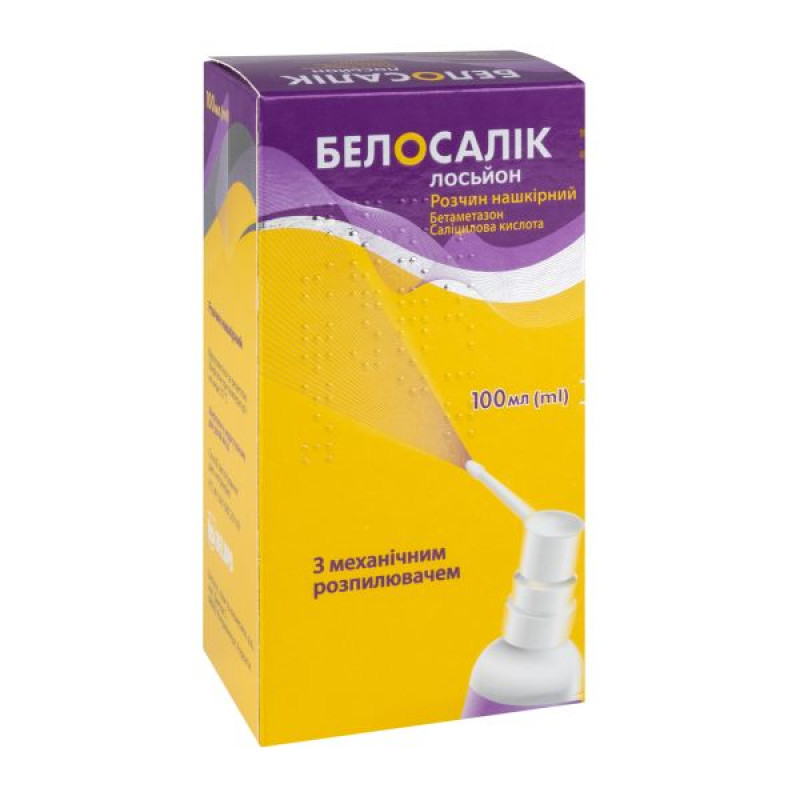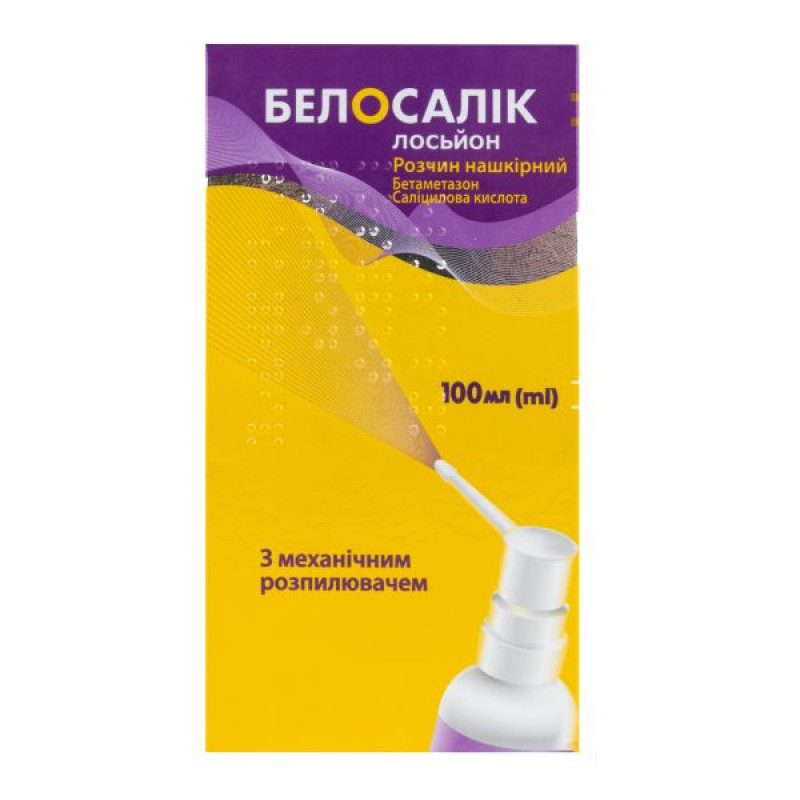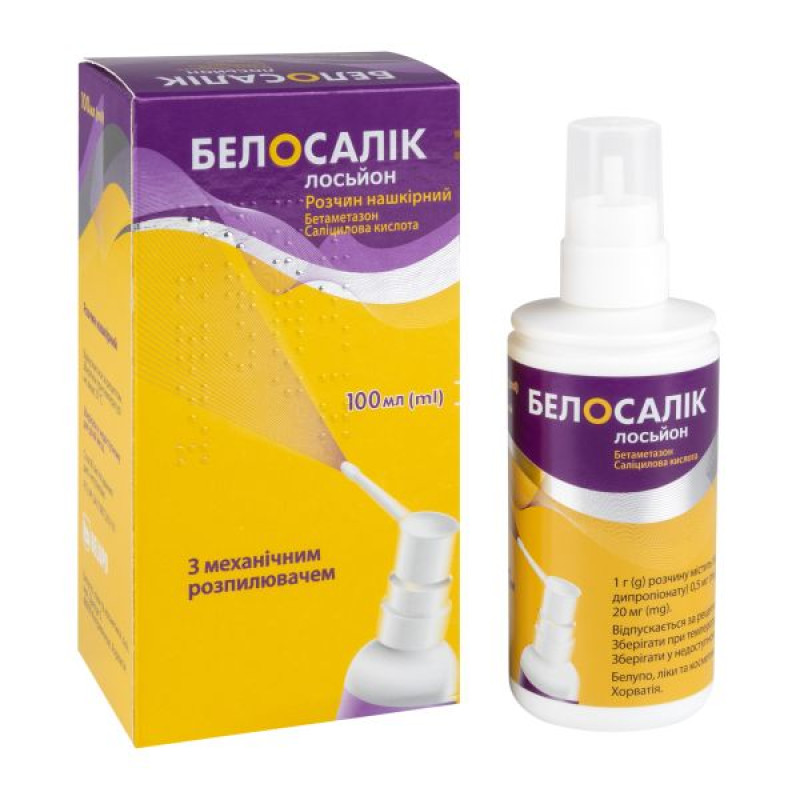Belosalik lotion solution for skin spray bottle 100 ml

Instructions Belosalik lotion solution for skin spray bottle 100 ml
Composition
active ingredients: betamethasone, salicylic acid;
1 g of solution contains betamethasone (in the form of dipropionate) 0.5 mg and salicylic acid 20 mg;
Excipients: disodium edetate, hypromellose, sodium hydroxide, isopropyl alcohol, purified water.
Dosage form
The solution is topical.
Main physicochemical properties: clear, colorless, viscous liquid with the odor of isopropanol.
Pharmacotherapeutic group
Corticosteroids for topical use in dermatology. Active corticosteroids in combination with other drugs. ATX code D07X C01.
Pharmacological properties
Pharmacodynamics
The drug is a combination of the corticosteroid betamethasone and salicylic acid.
Betamethasone is a synthetic fluorinated adrenocorticosteroid for topical use in dermatology that has potent anti-inflammatory, immunosuppressive, and antiproliferative effects. It is a synthetic analogue of prednisolone that exhibits a high degree of corticosteroid activity with little mineralocorticoid effect.
Corticosteroids reduce the production, release, and activity of chemical mediators of inflammation (kinins, histamine, lysosomal enzymes, prostaglandins). Since the presence of leukocytes and macrophages is necessary for the initiation of the inflammatory process, corticosteroids inhibit the migration of cells to the damaged site and reduce vasodilation and increased permeability of blood vessels at this site. This vasoconstrictor effect reduces extravasation and the occurrence of edema.
Corticosteroids exert an immunosuppressive effect on type III and IV hypersensitivity reactions by inhibiting the toxic action of the antigen-antibody complex deposited on the walls of blood vessels and causing cutaneous allergic vasculitis, as well as by inhibiting the action of lymphokines, target cells, and macrophages, which leads to a reaction in the form of allergic contact dermatitis. Corticosteroids also prevent the access of sensitized T lymphocytes and macrophages to target cells.
Salicylic acid has a keratolytic effect when applied topically, which facilitates the penetration of corticosteroids into the skin.
Pharmacokinetics
The absorption of betamethasone is influenced by many factors, including the presence of inflammation and the condition of the epidermis. When applied topically, corticosteroids may be absorbed to a lesser extent by normal, intact skin, and the presence of inflammatory processes in the skin may increase absorption. Systemic absorption after topical application is 12-14%. The volume of distribution (Vd) is 1.4 l/kg. Approximately 64% of betamethasone is reversibly bound to plasma proteins. Betamethasone is metabolized in the liver, with metabolites excreted primarily in the bile, with a smaller proportion in the urine (approximately 5% in total).
Salicylic acid, when applied to the skin under an occlusive dressing, reaches its peak plasma concentration after 5 hours. Approximately 6% of the total absorbed salicylic acid is excreted unchanged in the urine, while the majority is excreted as metabolites.
Indication
To reduce inflammatory symptoms of psoriasis and seborrhea of the scalp.
Contraindication
Hypersensitivity to betamethasone, salicylic acid or to any of the excipients of the drug. Also rosacea, acne, widespread plaque psoriasis, perianal and genital itching, diaper dermatitis, perioral dermatitis, rosacea, skin manifestations of syphilis, skin tuberculosis, other bacterial and fungal skin infections without adequate antibacterial and antifungal therapy, molluscum contagiosum, dermatomycoses, skin reactions after vaccination, varicose veins, viral infections (e.g. herpes simplex, shingles, chickenpox). Should not be used under occlusive dressings.
Interaction with other medicinal products and other types of interactions
Topical application of salicylic acid should not be combined with oral use of preparations containing acetylsalicylic acid and other nonsteroidal anti-inflammatory drugs. Do not use with benzoyl peroxide and topical retinoids.
Salicylic acid may increase the skin permeability of other topical medications and thereby increase their absorption into the body. In addition, salicylic acid may enhance the undesirable effects of methotrexate and the hypoglycemic effects of oral antidiabetic drugs, sulfonylureas.
Application features
The drug is not intended for use in ophthalmology. The drug cannot be used to treat the eyes and skin around the eyes due to the possibility of cataracts, glaucoma, fungal eye diseases, as well as exacerbation of herpes.
Avoid contact with eyes, mucous membranes, wound surfaces, and ulcers.
Prolonged topical use of the drug on the face is not recommended due to the possible occurrence of rosacea-like dermatitis, perioral dermatitis, and acne.
If skin irritation or hypersensitivity occurs during use of the product, treatment should be discontinued. In the event of infection, appropriate therapy should be prescribed.
Any side effects that occur with the use of systemic corticosteroids, including suppression of the function of the adrenal cortex, may also be observed with the local use of glucocorticosteroids, especially in children.
Long-term therapy with the drug should be avoided in all patients, regardless of age.
The drug should not be used under occlusive dressings.
Systemic absorption of topically applied glucocorticosteroids or salicylic acid will be higher if treatment is carried out on large body surfaces or when occlusive dressings are used. Appropriate precautions should be taken in such cases, especially when treating children.
Some areas of the body where there is natural occlusion (groin, armpits, perianal area) are more susceptible to the appearance of striae when treated topically with the drug, so its use in these areas should be limited as much as possible.
When dandruff or keratinization disappears, treatment should be continued with corticosteroids only.
If excessive dryness or increased skin irritation develops, the use of the drug should be discontinued.
Topical corticosteroids may cause psoriasis for several reasons, including symptom relapse with subsequent development of tolerance, risk of pustular psoriasis, and local systemic toxicity due to decreased skin barrier function. Patients with impaired liver function are more susceptible to systemic effects. Such patients should be closely monitored.
Periodic monitoring of the function of the hypothalamic-pituitary-adrenal system (urine and plasma free cortisol test, ACTH stimulation test) should be performed. If suppression of function is detected, the drug should be discontinued, the frequency of use reduced, or a less potent corticosteroid substituted.
Topical corticosteroids may distort the clinical picture.
Relapse is possible if treatment is interrupted. The infection may worsen and healing may be delayed.
The drug should not be applied to mucous membranes or areas around the eyes due to the keratolytic effect of salicylic acid.
It is contraindicated to apply the drug to areas with atrophied skin.
The drug should not be used to treat varicose veins.
Vision impairment
Visual disturbances are possible with systemic and topical corticosteroids (including intranasal, inhaled, and intraocular administration). If symptoms such as blurred vision or other visual disturbances occur, the patient should be evaluated by an ophthalmologist to evaluate possible causes of visual disturbances, which may include cataracts, glaucoma, or rare conditions such as central serous chorioretinopathy, which have been reported following the use of systemic and topical corticosteroids.
Use during pregnancy or breastfeeding
Pregnancy.
Since the safety of topical corticosteroids in pregnant women has not been established, the drug should not be used in the first trimester of pregnancy. The appointment of these drugs is possible only in later stages of pregnancy, if the expected benefit to the expectant mother clearly outweighs the potential risk to the fetus. Drugs of this group are contraindicated in pregnant women in high doses and for a long time.
Breastfeeding period.
It is currently unknown whether topical corticosteroids can penetrate into breast milk due to systemic absorption, therefore, when deciding whether to discontinue breastfeeding or discontinue the drug, the need for the drug should be taken into account.
Ability to influence reaction speed when driving vehicles or other mechanisms
The drug does not affect the reaction speed when driving or working with other mechanisms.
Method of administration and doses
The drug is for external use only.
Bottle with mechanical pump sprayer
Spray the drug twice a day on the affected areas of the scalp using the extended nozzle - sprayer.
Before spraying, shake the bottle, place it in a vertical position, then bring the nozzle to the affected scalp and press the sprayer all the way down with your index finger. Spray the required number of times onto the affected areas of the scalp.
Dropper bottle
Apply the product twice a day. Apply a few drops of lotion evenly to the affected areas with a cotton swab or fingers, and rub gently into the skin or scalp.
The frequency and duration of application, other than the recommended one, may be determined by the doctor, based on the severity of the disease. In mild cases, a single daily application is sufficient for some patients.
The drug should not be used in or near the eyes. The maximum daily dose should be gradually reduced to the lowest dose that controls symptoms.
The duration of treatment is determined by the doctor individually.
There are no clinical data on the use of the drug in children, so it is undesirable to use it in patients of this age group.
Because children have a greater body surface area to body weight ratio than adults, and therefore greater absorption of the drug, they are at greater risk of hypothalamic-pituitary-adrenal (HPA) suppression by corticosteroids and the development of exogenous corticosteroid effects.
In children receiving topical corticosteroids, adrenal suppression, Cushing's syndrome, growth retardation, insufficient weight gain, and increased intracranial pressure have been reported.
Manifestations of adrenal suppression: low plasma cortisol levels and no response to ACTH-stimulated adrenal stimulation test. Increased intracranial pressure is manifested by fontanelle protrusion, headache, and bilateral optic disc edema.
Overdose
With prolonged or excessive use of local glucocorticosteroids, suppression of pituitary-adrenal function with the development of secondary adrenal insufficiency and the appearance of symptoms of hypercorticism, including Cushing's disease, is possible. Excessive or prolonged use of topical preparations with salicylic acid can cause the appearance of symptoms of salicism. Symptoms of an overdose of salicylates are pallor, increased fatigue, drowsiness, nausea, vomiting, hearing impairment.
Treatment. Administer appropriate symptomatic therapy. Symptoms of acute hypercorticism are usually reversible. If necessary, correct electrolyte imbalance. In case of chronic toxicity, gradual withdrawal of corticosteroids is recommended.
Treatment of salicism is symptomatic. Take measures to more quickly remove salicylates from the body. In case of overgrowth of resistant microorganisms, it is recommended to stop treatment with the drug and prescribe the necessary therapy. Use sodium bicarbonate orally to alkalize the urine and increase diuresis.
Side effects
The following adverse reactions may occur with the use of topical corticosteroids: burning sensation, itching, irritation, dry skin, tingling skin, skin thickening, skin cracking, feeling of warmth, flaky skin, focal skin peeling, erythema, folliculitis, hypertrichosis, acneiform eruptions, hypopigmentation, perioral dermatitis and allergic contact dermatitis.
The following adverse reactions may occur more frequently with the use of occlusive dressings: skin maceration, secondary infection, skin atrophy, striae and perspiration.
Hypersensitivity reactions are possible in individuals with individual intolerance to any component of the drug.
Stretch marks and dilated blood vessels, mainly on the face, may result from prolonged continuous application of the drug.
Blurred vision (see also section 4.4) has been reported with the use of corticosteroids (frequency unknown).
Any adverse events that occur with systemic use of glucocorticoids, including adrenal suppression, may also occur with their topical use.
With topical application of salicylic acid, the following skin changes may be observed: dryness, peeling, irritation, contact dermatitis, manifestations of allergic reactions (urticaria, itching), which require discontinuation of the drug.
With prolonged use, absorption of the drug into the general bloodstream and the development of side effects typical of salicylates are possible: tinnitus, dizziness, epigastric pain, nausea, vomiting, acidosis, rapid breathing.
Expiration date
2 years.
Storage conditions
Store at a temperature not exceeding 25 °C.
Keep out of reach of children.
Packaging
50 ml or 100 ml in a dropper bottle; 1 bottle in a cardboard box.
20 ml or 50 ml or 100 ml in a bottle with a mechanical pump sprayer; 1 bottle in a cardboard box.
Vacation category
According to the recipe.
Producer
Belupo, medicines and cosmetics, etc.
Address
Danica Street 5, 48000 Koprivnica, Croatia.
There are no reviews for this product.
There are no reviews for this product, be the first to leave your review.
No questions about this product, be the first and ask your question.





